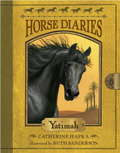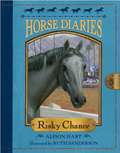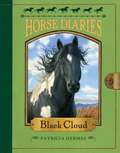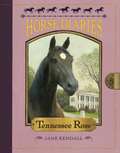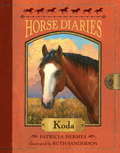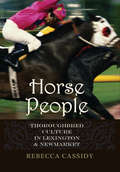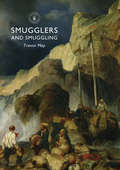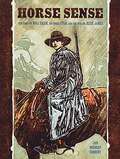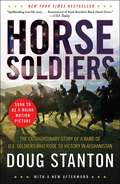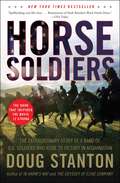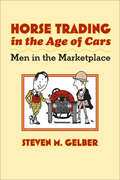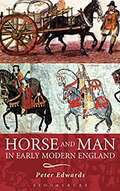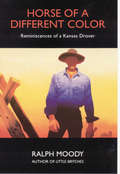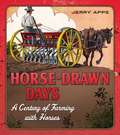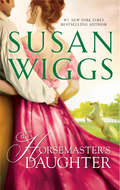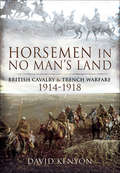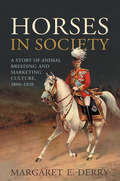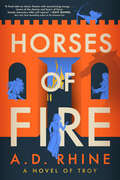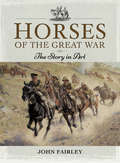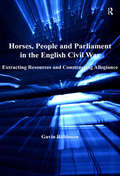- Table View
- List View
Horse Diaries #6: Yatimah
by Catherine Hapka Ruth SandersonFor all lovers of horses and history, it's the next book in the popular Horse Diaries series. Born in the Arabian Desert in the ninth century, Yatimah is a black Arabian filly whose name means "orphan." She enjoys her life at the oasis, with sheep to tease, other foals to race, and the daughter of her Bedouin owner to take care of her. But when the colt who is her foster brother is stolen in a raid, Yatimah realizes her true birthright. Like Black Beauty, this moving novel is told in first person from the horse's own point of view and includes an appendix full of photos and facts about Arabian horses and Bedouin culture.From the Trade Paperback edition.
Horse Diaries #6: Yatimah
by Catherine Hapka Ruth SandersonFor all lovers of horses and history, it's the next book in the popular Horse Diaries series. Born in the Arabian Desert in the ninth century, Yatimah is a black Arabian filly whose name means "orphan." She enjoys her life at the oasis, with sheep to tease, other foals to race, and the daughter of her Bedouin owner to take care of her. But when the colt who is her foster brother is stolen in a raid, Yatimah realizes her true birthright. Like Black Beauty, this moving novel is told in first person from the horse's own point of view and includes an appendix full of photos and facts about Arabian horses and Bedouin culture.From the Trade Paperback edition.
Horse Diaries #7: Risky Chance (Horse Diaries #7)
by Alison Hart Ruth SandersonFor all lovers of horses and history, it's the next book in the popular Horse Diaries series. Born in California at the start of the Great Depression, Risky Chance is a gray thoroughbred who was born to race. Life at the track and being spoiled by his jockey's young daughter, Marie, is all Chance could ask for. He loves nothing more than running fast and winning. But after an accident, Chance discovers a side of horse racing that has little to do with glory.Like Black Beauty, this moving novel is told in first person from the horse's own point of view and includes an appendix full of photos and facts about thoroughbreds, horse racing, and the Great Depression.From the Trade Paperback edition.
Horse Diaries #8: Black Cloud (Horse Diaries #8)
by Patricia Hermes Astrid SheckelsBorn in Northern Nevada in 1950, Black Cloud is a black-and-white mustang colt. He loves roaming free with the rest of his herd, playing with the other foals, and learning the ways of wild horses. But when humans intrude on this wandering life, Black Cloud's worled is changed forever. Like Black Beauty, this moving novel is told in first person from the horse's own point of view and includes an appendix full of photos and facts about mustangs and the history of the laws protecting them.From the Trade Paperback edition.
Horse Diaries #9: Tennessee Rose (Horse Diaries #9)
by Jane Kendall Astrid SheckelsAlabama, 1856. Tennessee Rose is a dark bay Tennessee Walking Horse with a rose-shaped marking on her forehead. She loves dashing around the plantation in the running walk that her breed is famous for, then coming back to her comfortable stall and her friend Levi, the slave boy who is her groom. But as the Civil War approaches, Rosie begins to question plantation life. Is slavery fair? Could Levi be free? Like Black Beauty, this moving novel is told in first person from the horse's point of view and includes an appendix full of photos and facts about Tennessee Walking Horses and the Civil War.
Horse Diaries: Koda
by Patricia HermesFor anyone who has ever dreamed of hearing a horse’s story . . . Independence, Missouri, 1846 Koda is a bay quarter horse with a white blaze. He loves to explore the countryside and run free with his human friend Jasmine nearby. But after Koda sets out with Jasmine’s family on a long and dusty wagon train journey on the Oregon Trail, he finds out what is truly important to him. Here is Koda’s story . . . in his own words. With moving and knowledgeable text and lovely black-and-white art throughout—both by real horse people—this is the perfect fit for all lovers of horses and history! From the Trade Paperback edition.
Horse People: Thoroughbred Culture in Lexington and Newmarket (Animals, History, Culture)
by Rebecca Louise CassidyThe world of Thoroughbred racing is glamorous, secretive, dangerous, and seductive—the sport of kings and the poor man's obsession. While the spectacle of racing stirs the imagination, it belies the ruthless business that lies beneath.This engaging original study demystifies this complex world by comparing centers of excellence in Britain and North America. Drawing from intensive field work in Suffolk's Newmarket and Kentucky's Lexington, Rebecca Cassidy gives us the inside track on all players in the industry—from the elite breeders and owners to the stable boys, racetrack workers, and veterinarians. She leads us through horse farms, breeding barns, and yearling sales; explains rigorous training regimens; and brings us trackside on race day.But the history of Thoroughbred racing culture is more than a collection of fascinating characters and exciting events. Cassidy's investigation reveals the factors—ethical, cultural, political, and economic—that have shaped the racing tradition.
Horse Racing in Britain and Ireland
by Anne HollandHistorian and experienced rider Anne Holland explores the history of horse racing, from the horses and jockeys, the history and racecourses, to betting and race-goers. The "Sport of Kings," racing dates back to contests between chariots at the ancient Olympics. Racing came to Britain with the Romans, and its popularity, particularly among the elite, led to the creation of the thoroughbred racehorse; and the establishment of a racing calendar with flat races and steeple chases at a plethora of dedicated racecourses around the country. Attending the races is a social activity no longer restricted to the elite, to the point that some racegoers enjoy a day out without every turning to watch the horses race by.
Horse Racing's Holy Grail: The Epic Quest For The Kentucky Derby
by Steve HaskinInterlaced with humor, this book looks at the pitfalls and pressures owners, trainers, and jockeys face at Derby time and why most fail, while others, notably the "big three" of D. Wayne Lukas, Bob Baffert, and Nick Zito, always seem to win the big prize.
Horse Sense: The Story of Will Sasse, His Horse Star, and the Outlaw Jesse James
by Janet Neubert SchultzWill Sasse is sick of his pa's slow, careful ways. Pa says only sturdy workhorses are worth raising out in farm country. Will wants to raise beautiful pleasure horses like his mare, Star. So what if it's a risk? Will wishes Pa was more like Jesse, a daring new friend. When Will is caught in a bloody shootout and a fatally botched bank robbery, he realizes that his friend is really the outlaw Jesse James. The James Gang is escaping—and they're taking Star with them. Will joins a posse in pursuit of the outlaws. As the posse closes in, Will realizes that he must make a choice—what kind of life does he really want?
Horse Soldiers
by Doug Stanton<P>From the New York Times bestselling author of In Harm's Way comes a true-life story of American soldiers overcoming great odds to achieve a stunning military victory. Horse Soldiers is the dramatic account of a small band of Special Forces soldiers who secretly entered Afghanistan following 9/11 and rode to war on horses against the Taliban. <P>Outnumbered forty to one, they pursued the enemy army across the mountainous Afghanistan terrain and, after a series of intense battles, captured the city of Mazar-i-Sharif, which was strategically essential to defeat their opponent throughout the country. <P>The bone-weary American soldiers were welcomed as liberators as they rode into the city, and the streets thronged with Afghans overjoyed that the Taliban regime had been overthrown. <P>Then the action took a wholly unexpected turn. During a surrender of six hundred Taliban troops, the Horse Soldiers were ambushed by the would-be POWs. Dangerously overpowered, they fought for their lives in the city's immense fortress, Qala-i-Janghi, or the House of War. At risk were the military gains of the entire campaign: if the soldiers perished or were captured, the entire effort to outmaneuver the Taliban was likely doomed. <P>Deeply researched and beautifully written, Stanton's account of the Americans' quest to liberate an oppressed people touches the mythic. The soldiers on horses combined ancient strategies of cavalry warfare with twenty-first-century aerial bombardment technology to perform a seemingly impossible feat. Moreover, their careful effort to win the hearts of local townspeople proved a valuable lesson for America's ongoing efforts in Afghanistan. <P><b>A New York Times Bestseller</b>
Horse Soldiers: The Extraordinary Story of a Band of US Soldiers Who Rode to Victory in Afghanistan
by Doug StantonFrom the New York Times bestselling author of In Harm’s Way comes a true-life story of American soldiers overcoming great odds to achieve a stunning military victory. Horse Soldiers is the dramatic account of a small band of Special Forces soldiers who secretly entered Afghanistan following 9/11 and rode to war on horses against the Taliban. Outnumbered forty to one, they pursued the enemy army across the mountainous Afghanistan terrain and, after a series of intense battles, captured the city of Mazar-i-Sharif, which was strategically essential to defeat their opponent throughout the country. The bone-weary American soldiers were welcomed as liberators as they rode into the city, and the streets thronged with Afghans overjoyed that the Taliban regime had been overthrown. Then the action took a wholly unexpected turn. During a surrender of six hundred Taliban troops, the Horse Soldiers were ambushed by the would-be POWs. Dangerously overpowered, they fought for their lives in the city’s immense fortress, Qala-i-Janghi, or the House of War. At risk were the military gains of the entire campaign: if the soldiers perished or were captured, the entire effort to outmaneuver the Taliban was likely doomed. Deeply researched and beautifully written, Stanton’s account of the Americans’ quest to liberate an oppressed people touches the mythic. The soldiers on horses combined ancient strategies of cavalry warfare with twenty-first-century aerial bombardment technology to perform a seemingly impossible feat. Moreover, their careful effort to win the hearts of local townspeople proved a valuable lesson for America’s ongoing efforts in Afghanistan.
Horse Trading in the Age of Cars: Men in the Marketplace (Gender Relations in the American Experience)
by Steven M. GelberThe trading, selling, and buying of personal transport has changed little over the past one hundred years. Whether horse trading in the early twentieth century or car buying today, haggling over prices has been the common practice of buyers and sellers alike. Horse Trading in the Age of Cars offers a fascinating study of the process of buying an automobile in a historical and gendered context. Steven M. Gelber convincingly demonstrates that the combative and frequently dishonest culture of the showroom floor is a historical artifact whose origins lie in the history of horse trading. Bartering and bargaining were the norm in this predominantly male transaction, with both buyers and sellers staking their reputations and pride on their ability to negotiate the better deal. Gelber comments on this point-of-sale behavior and what it reveals about American men. Gelber's highly readable and lively prose makes clear how this unique economic ritual survived into the industrial twentieth century, in the process adding a colorful and interesting chapter to the history of the automobile.
Horse and Man in Early Modern England
by Peter EdwardsHorses were used for many purposes in Shakespeare's England: for travel, either on horseback or in carriages, for haulage and for pleasure, and for work in the fields. The upper classes were closely involved with horses, for jousting, hunting and racing. Horses was also essential to any army, both as cavalry and to draw supplies and artillery. Horse ownership was, however, much more widespread than might be imagined. <p><p> Horse and Man in Early Modern England shows how, in pre-industrial England, horses were bred and trained, what they ate, how much they were worth, how long they lived, and what their owners thought of them. <p><p> While they were named individually, and sometimes became favourites, many were worked hard and poorly treated, leading to their early deaths. They were, nevertheless an essential part of the life of the time and are strikingly depicted in literature and art, as well in many other records.
Horse of a Different Color: Reminiscences of a Kansas Drover
by Ralph MoodyHorse of a Different Color ends the "roving days" of young Ralph Moody. His saga began on a Colorado ranch in Little Britches and continued at points east and west in Man of the Family, The Fields of Home, The Home Ranch, Mary Emma & Company, Shaking the Nickel Bush, and The Dry Divide. All have been reprinted as Bison Books.
Horse's Arse
by Charlie OwenIt is the Seventies and Horse’s Arse is the affectionate name for Handstead New Town, a North Manchester overspill and an unholy dump. The police use it as a penal posting – all the bad egg coppers end up there. Worst amongst the residents of Handstead are the Park Royal Mafia, a gang of violent thugs who terrorise their neighbourhood. They and the officers doomed to serve at Handstead wrestle constantly for dominance. This is the story of some of those police officers - the Grim Brothers, Psycho, Pizza, Piggy Malone and others, a group of hooligans in uniform and their journey through excess, despair and finally some form of salvation...
Horse's Arse
by Charlie OwenIt is the Seventies and Horse?s Arse is the affectionate name for Handstead New Town, a North Manchester overspill and an unholy dump. The police use it as a penal posting ? all the bad egg coppers end up there. Worst amongst the residents of Handstead are the Park Royal Mafia, a gang of violent thugs who terrorise their neighbourhood. They and the officers doomed to serve at Handstead wrestle constantly for dominance. This is the story of some of those police officers - the Grim Brothers, Psycho, Pizza, Piggy Malone and others, a group of hooligans in uniform and their journey through excess, despair and finally some form of salvation...
Horse-Drawn Days: A Century of Farming with Horses
by Jerry AppsHorse-Drawn Days: A Century of Farming with Horses captures stories of rural life at a time when a team of horses was a vital part of the farm family. Author Jerry Apps pairs lively historic narrative with reminiscences about his boyhood on the family farm in Wisconsin to paint a vivid picture of a bygone time. Featuring fascinating historic photos, ads, and posters, plus contemporary color photos of working horses today, Horse-Drawn Days evokes the majesty of these animals and illuminates the horse’s role in our country’s early history and our rural heritage.
Horsemaster's Daughter
by Susan WiggsAn unbroken horse, a broken man, an estate that needed herOnce a privileged son of the South, Hunter Calhoun now stands a widower shadowed by the scandal of his wife's death. Burying himself in his success with breeding Thoroughbred racehorses, he's left his family to crumble and forgotten how to comfort his grieving children. When a prized stallion arrives from Ireland crazed and unridable, Hunter is forced to seek help for the beast. Removed from the world of wealth and social privilege, Eliza Fylte has inherited her father's famed gift for gentling horses. And when Hunter arrives with his wild steed, her healing spirit reaches further yet, drawing her to his shattered family and to the intense, bitter man who needs her, just as she needs him.Eliza understands what Hunter refuses to see--that love is the greatest healer of all. But can her kind, humble being manage to teach such an untethered man what truly matters in life?
Horsemen in No Man's Land: British Cavalry & Trench Warfare, 1914–1918
by David KenyonOf what use was the British cavalry during the years of trench warfare on the Western Front? On a static battlefield dominated by the weapons of the industrial age, by the machine gun and massed artillery, the cavalry was seen as an anachronism. It was vulnerable to modern armaments, of little value in combat and a waste of scarce resources.At least, that is the common viewpoint. Indeed, the cavalry have been consistently underestimated since the first histories of the Great War were written. But, in light of modern research, is this the right verdict?David Kenyon seeks to answer this question in his thought-provoking new study. His conclusions challenge conventional wisdom on the subject they should prompt a radical reevaluation of the role of the horseman on the battlefields of France and Flanders a century ago.Using evidence gained from research into wartime records and the eyewitness accounts of the men who were there who saw the cavalry in action he reassesses the cavalry's contribution and performance. His writing gives a vivid insight into cavalry tactics and the ethos of the cavalrymen of the time. He also examines how the cavalry combined with the other arms of the British army, in particular the tanks.His well-balanced and original study will be essential reading for students of the Western Front and for anyone who is interested in the long history of cavalry combat.
Horses in Society
by Margaret E. DerryBefore crude oil and the combustion engine, the industrialized world relied on a different kind of power - the power of the horse. Horses in Society is the story of horse production in the United States, Britain, and Canada at the height of the species' usefulness, the late nineteenth and early twentieth-century. Margaret E. Derry shows how horse breeding practices used during this period to heighten the value of the animals in the marketplace incorporated a intriguing cross section of influences, including Mendelism, eugenics, and Darwinism.Derry elucidates the increasingly complex horse world by looking at the international trade in army horses, the regulations put in place by different countries to enforce better horse breeding, and general aspects of the dynamics of the horse market. Because it is a story of how certain groups attempted to control the market for horses, by protecting their breeding activities or 'patenting' their work, Horses in Society provides valuable background information to the rapidly developing present-day problem of biological ownership. Derry's fascinating study is also a story of the evolution of animal medicine and humanitarian movements, and of international relations, particularly between Canada and the United States.
Horses of Fire: A Novel of Troy
by A. D. Rhine&“One of those singular books that pulls readers into a completely immersive world with a dazzling story and characters so deftly drawn that you can&’t help but ache for them.&”–New York Times bestselling author Lisa MaxwellI know the stories they will tell. I&’ve heard the echoes of their songs—songs that will outlive us all. But this song is not theirs. It is mine. Behind the timeless tale you know is the captivating story you never heard: a sweeping epic in which Troy&’s strong, yet misunderstood women take center stage in the most famous war in history. Andromache is cast as the doting wife of Prince Hector, yet her Amazon warrior name means &“battler of men.&” The only one with the cunning to outwit the invading Greeks, she must gather a band of outcasts and become the military commander she was born to be before the life she and Hector have built is reduced to ashes. Rhea is a war refugee and a horse whisperer who finally earns a place and sense of belonging in Hector&’s stables. To save her new home, she must become an unlikely spy and face down a forbidden love that will test all her loyalties. Helen is blamed by all for starting the Trojan War, but no one knows her real story. To escape her tormentor and foil a plot to undermine Hector, Helen must risk everything by revealing her true face to the one who despises her most. Set in the wider landscape of the late Bronze Age collapse, this realistic and immersive Troy is a perilous battleground for warriors and politicians alike, not a playground where the fate of men and women make sport for gods and goddesses. The first book in an epic duology, Horses of Fire is a harrowing novel of palace intrigue, the transcendent bond of female friendship, and the everyday bravery of invisible heroes in times of war. The women of Troy are threads spinning on a single loom. Can they reweave the tapestry of fate?
Horses of the Great War: The Story in Art
by John FairleyHorses of the Great War explains the contribution of countless innocent houses using superb contemporary painting by artists such as Sir John Lavery, Sir Alfred Munnings and Stanley Spencer. These works supported by informed commentary tell how the horses were rounded up; how the cavalry halted the German advance in 1914 and again in 1918; how the turks were overwhelmed in the deserts of Palestine and Arabia. Most significantly the Western Front relied on horses for supply of everything from shells and ammunition to food and water in atrocious and perilous conditions. While the vets kept the surviving horses alive and well, in the end, vast numbers were slaughtered or sold.
Horses, People and Parliament in the English Civil War: Extracting Resources and Constructing Allegiance
by Gavin RobinsonHorses played a major role in the military, economic, social and cultural history of early-modern England. This book uses the supply of horses to parliamentary armies during the English Civil War to make two related points. Firstly it shows how control of resources - although vital to success - is contingent upon a variety of logistical and political considerations. It then demonstrates how competition for resources and construction of individuals’ identities and allegiances fed into each other. Resources, such as horses, did not automatically flow out of areas which were nominally under Parliament’s control. Parliament had to construct administrative systems and make them work. This was not easy when only a minority of the population actively supported either side and property rights had to be negotiated, so the success of these negotiations was never a foregone conclusion. The study also demonstrates how competition for resources and construction of identities fed into each other. It argues that allegiance was not a fixed underlying condition, but was something external and changeable. Actions were more important than thoughts and to secure victory, both sides needed people to do things rather than feel vaguely sympathetic. Furthermore, identities were not always self-fashioned but could be imposed on people against their will, making them liable to disarmament, sequestration, fines or imprisonment. More than simply a book about resources and logistics, this study poses fundamental questions of identity construction, showing how culture and reality influence each other. Through an exploration of Parliament’s interaction with local communities and individuals, it reveals fascinating intersections between military necessity and issues of gender, patriarchy, religion, bureaucracy, nationalism and allegiance.
